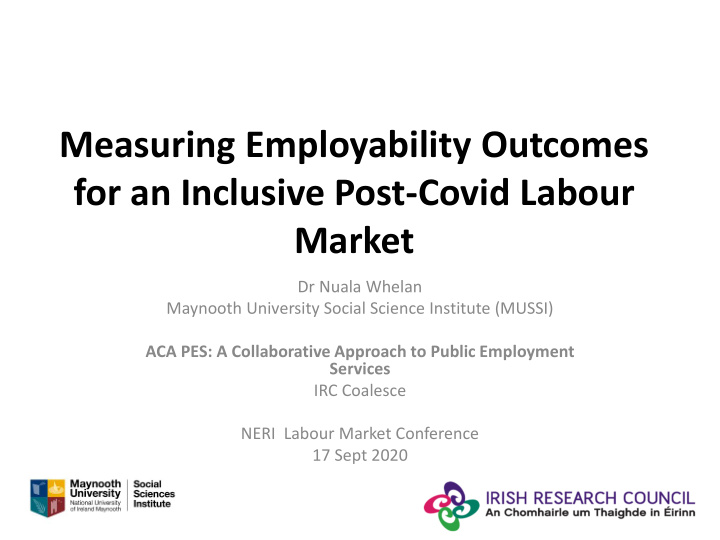



Measuring Employability Outcomes for an Inclusive Post-Covid Labour Market Dr Nuala Whelan Maynooth University Social Science Institute (MUSSI) ACA PES: A Collaborative Approach to Public Employment Services IRC Coalesce NERI Labour Market Conference 17 Sept 2020
The Challenge • Post pandemic unemployment Reverse the • LTU, young people, low skilled, be inclusive negative of those more migrant workers impacts of marginalised unemployment • Sectors enable and protect those Find mechanisms to support unemployed facilitate the who face people to find good jobs development involuntary of resilient work- Outcome should be decent work leading labour forces transitions to increased well-being and access to the capacity opportunity to do this - support equal access / workers at all Increased recognition that Post Covid PES no one is left career stages behind – Role ‘caring for’ the labour force – Regain confidence new work environments – Access sustainable employment • ALMPs are the primary vehicle to – Achieve potential improve employability in the – Strengthening the labour force unemployed • Post pandemic risk The enabling potential of employment related ‘any job is better than no job’ may guidance in caring for a prevail due to political, economic and distressed labour force societal pressures to reduce large and responding to varying numbers of unemployed individual needs has never been more important.
Effectiveness of ALMP ?? • Relatively little evidence on the effectiveness of ALMPs • Evaluations of ALMPs tend to be conducted using econometric impact evaluations, RCTs, Experimental methods • Effectiveness generally assessed in terms of impact on re-employment often absence of other effects e.g. increased employability, improved well-being, hopefulness, self-esteem, factors shown to enable and support re-employment lack analysis of the intervention content and its implementation capacity to illustrate what elements of the intervention worked for whom and under what circumstances, the ‘black box’ of interventions is limited (Bredgaard,2015) • Quality and conditions of the service, and its implementation by case workers , affect the capability set or range of options available to job seekers (Bartelheimer et al. , 2012) • Evaluations that delve deeper into interventions for the unemployed could provide better evidence and ultimately improve policy making.
What works? Work-first programmes e.g. job-search assistance and sanction/threat programmes, tend to have larger short-term effects than human capital programmes (small or even negative impacts in the short- term) Human capital programmes larger impacts if evaluated over a longer time period i.e. two to three years after completion. Triage potential gains from matching participants and programme types, programmes may work better for some than for others, depending on their labour useful in terms of identifying the market needs effectiveness of an intervention on job placement BUT tell us little about why they work, for whom they work best, and whether success is context specific
Labour Market Policy Options Human Capital Work-First Development Activation Holistic Skill / Competence Avoids prolonged Capability, Wellbeing unemployment development Prioritising life needs Empowering Sustainable access Intensive job search Capability / Wellbeing Freedom to choose In-work transitions/ Speedy return to work Networked / Flexible Co-design career development Monitoring Activity/compliance Work-Life approach Decent ‘work-first’ for those more distant sustainable approach for from the labour market the job ready - ALMP Rationale for employability programmes, Program targets, Intervention model, Relationship to labour market , Relationship with individuals (engagement), Locus of control, Conceptualisation of the individual, Institutions involved, Time, Employability type, ‘Missing middle’ implementation, Role and extent of employment guidance
Alternative policy approaches lead to different guidance models WORK-LIFE WORK-FIRST LIFE-FIRST HUMAN CAPITAL Available to all, goes DEVELOPMENT PES employment Widespread availability, hand in hand with guidance as a subset recognises Limited to those good triage and of lifelong guidance, intersectionality, driven who need it, time needs assessment, predominately by an understanding of bound, monitored, driven by an productivist, labour the self, an driven by an understanding of understanding of market focused, understanding of the self and an short-term context, and a belief in the self (person – understanding of outcomes related to transforming contexts environment fit). context (narrative immediate entry (life design/ psychology Medium-term and developmental). into employment. of working). PES outcomes including PES guidance Limited and short guidance focuses on the development of focuses on longer- enabling career term, still adheres to employability and term outcomes monitoring and management and career management including the sanctions. Focus is making educational, skills, and those development of on job matching training and education or employability and (some use of person occupational choices training outcomes career management that are right for the –environment fit) which lead to skills, leading to individual. It helps employment sustainable people to reflect on employability across their ambitions, the lifecycle interests, qualifications, skills and talents Robust triage is vital - evidence that intensive interventions can work (e.g. EEPIC, SICAP) Need experienced case workers, local interagency working, time, good employer links
Outcomes Work First Human Capital Job Development Placement Work Life balance Education and Training leading to employment Life First Employability skills & attributes (incl. self esteem, hopefulness), Balance with life needs (household circumstances), work culture, access to resources, career management, education and training leading to sustainable employment Sense of self, barriers, referral, 'life' issues to be considered as part of career planning, knowledge of interests, strengths, skills, potential, work environments, values. Improved Self-esteem, hopefulness, motivation, well-being, Career goals, Career identity, Career clarity, Decision making, Problem solving, Goal setting, Agency
What to measure?? ACA PES work in progress Friday 18 th Sept Digitalisation in Public Employment and Guidance Services: How apps and algorithms are changing the face Adoption of requires different of welfare delivery alternative / outcome targets wider approaches and metrics Sept – Dec 2020 • ACA PES Guidance tool-kit • ACA PES Metric Jan – May 2021 • One-to-one tailored supports = a range • Pilot with LES of activities June 2021 • Engagement, coaching and mentoring, • Final Conference employment guidance, career exploration, mental health support, basic and specific skills, job search Nuala.whelan@mu.ie assistance, CV preparation, perceived Mary.p.murphy@mu.ie and practical barriers….
Recommend
More recommend